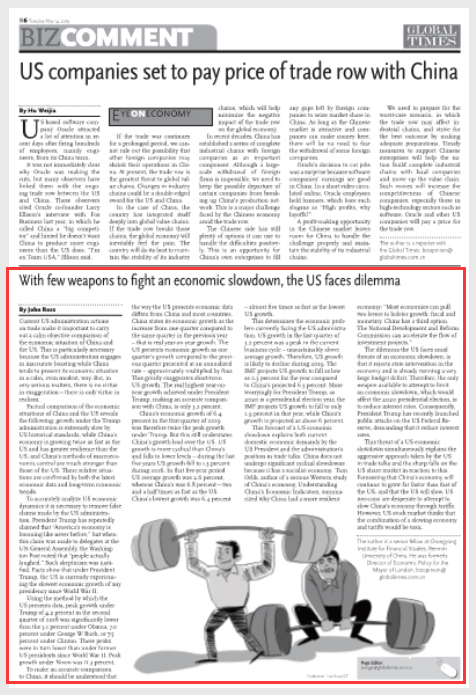Major Power Relations
Your Present Location: PROGRAMS> Major Power RelationsJohn Ross: With few weapons to fight an economic slowdown, the US faces dilemma
By John Ross Source: Global Times Published: 2019-5-13
Current US administration actions on trade make it important to carry out a calm objective comparison of the economic situation of China and the US. This is particularly necessary because the US administration engages in inaccurate boasting while China tends to present its economic situation in a calm, even modest, way. But, in very serious matters, there is no virtue in exaggeration -- there is only virtue in realism.

Factual comparison of the economic situations of China and the US reveals the following: growth under the Trump administration is extremely slow by US historical standards, while China's economy is growing twice as fast as the US and has greater resilience than the US, and China's methods of macroeconomic control are much stronger than those of the US. These relative situations are confirmed by both the latest economic data and long-term economic trends.
To accurately analyze US economic dynamics it is necessary to remove false claims made by the US administration. President Trump has repeatedly claimed that "America's economy is booming like never before," but when this claim was made to delegates at the UN General Assembly, the Washington Post noted that "people actually laughed." Such skepticism was justified. Facts show that under President Trump, the US is currently experiencing the slowest economic growth of any presidency since World War II.
Using the method by which the US presents data, peak growth under Trump of 4.2 percent in the second quarter of 2018 was significantly lower than the 5.1 percent under Obama, 7.0 percent under George W Bush, or 7.5 percent under Clinton. These peaks were in turn lower than under former US presidents since World War II. Peak growth under Nixon was 11.3 percent.
To make an accurate comparison to China, it should be understood that the way the US presents economic data differs from China and most countries. China states its economic growth as the increase from one quarter compared to the same quarter in the previous year - that is real year-on-year growth. The US presents economic growth as one quarter's growth compared to the previous quarter presented at an annualized rate - approximately multiplied by four. This greatly exaggerates short-term US growth. The real highest year-on-year growth achieved under President Trump, making an accurate comparison with China, is only 3.2 percent.
China's economic growth of 6.4 percent in the first quarter of 2019 was therefore twice the peak growth under Trump. But this still understates China's growth lead over the US. US growth is more cyclical than China's and falls to lower levels - during the last five years US growth fell to 1.3 percent during 2016. In that five-year period US average growth was 2.6 percent, whereas China's was 6.8 percent -- two and a half times as fast as the US. China's lowest growth was 6.4 percent - almost five times as fast as the lowest US growth.
This determines the economic problem currently facing the US administration. US growth in the last quarter of 3.2 percent was a peak in the current business cycle - unsustainably above average growth. Therefore, US growth is likely to decline during 2019. The IMF projects US growth to fall as low as 2.3 percent for the year compared to China's projected 6.3 percent. More worryingly for President Trump, as 2020 is a presidential election year, the IMF projects US growth to fall to only 1.9 percent in that year, while China's growth is projected as above 6 percent.
This forecast of a US economic slowdown explains both current domestic economic demands by the US President and the administration's position in trade talks. China does not undergo significant cyclical slowdowns because it has a socialist economy. Tom Orlik, author of a serious Western study of China's economy, Understanding China's Economic Indicators, summarized why China had a more resilient economy: "Most economies can pull two levers to bolster growth: fiscal and monetary. China has a third option. The National Development and Reform Commission can accelerate the flow of investment projects."
The dilemma the US faces amid threats of an economic slowdown, is that it rejects state intervention in the economy and is already running a very large budget deficit. Therefore, the only weapon available to attempt to limit an economic slowdown, which would affect the 2020 presidential election, is to reduce interest rates. Consequently, President Trump has recently launched public attacks on the US Federal Reserve, demanding that it reduce interest rates.
This threat of a US economic slowdown simultaneously explains the aggressive approach taken by the US in trade talks and the sharp falls on the US share market in reaction to this. Foreseeing that China's economy will continue to grow far faster than that of the US, and that the US will slow, US neo-cons are desperate to attempt to slow China's economy through tariffs. However, US stock market thinks that the combination of a slowing economy and tariffs would be toxic.
The author is a senior fellow at Chongyang Institute for Financial Studies, Renmin University of China. He was formerly Director of Economic Policy for the Mayor of London.























































































 京公网安备 11010802037854号
京公网安备 11010802037854号





